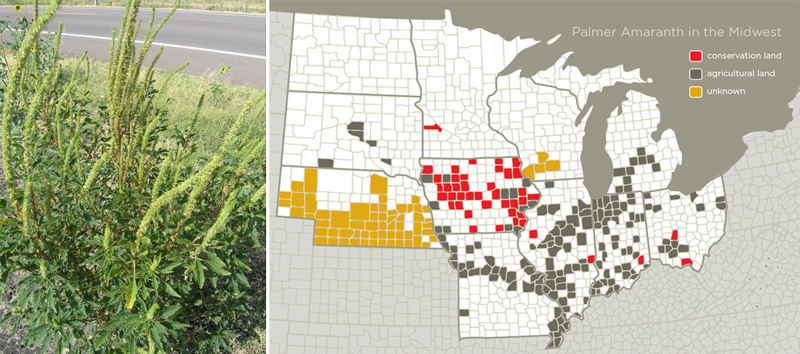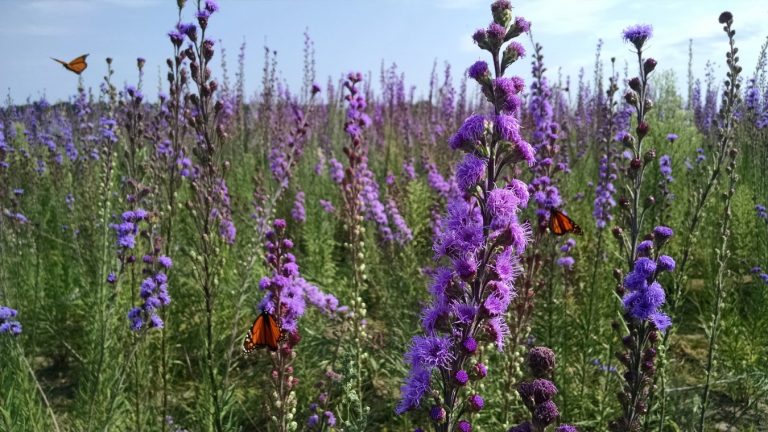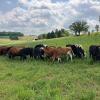“It’s disappointing to see this problem associated with conservation seed mixes.”
That’s the response from a friend and native seed producer when I mentioned the news that Palmer amaranth (Amaranthus palmeri), a highly invasive noxious weed has now appeared in several states across the Midwest. The weed was possibly introduced outside of its native range as an accidental contaminant in wildflower seed mixes sold for pollinator habitat restoration. For the native seed industry, for farmers, and for anyone who cares about pollinator conservation, this is indeed disappointing.
Native to southern states and historically not a major weed, Palmer amaranth, which can produce more than a half-million seeds per plant, has spread widely in recent years after developing resistance to the broad-spectrum herbicide glyphosate. Where crops such as corn, cotton, and soybean have been genetically modified for glyphosate resistance, this trait arose naturally in Palmer amaranth. To date, a small number of naturally-herbicide resistant plants have survived and reproduced, but Palmer amaranth, with its prolific rate of seed production, may now be considered a poster-child for a new generation of agricultural ‘superweeds.’
News of Palmer amaranth showing up in newly planted wildflower plots began circulating last summer, first in Illinois and Iowa, and later in Minnesota and South Dakota. Further investigation by state weed management agencies and Extension personnel confirmed the plant’s identity, and a correlation was quickly made between its sudden appearance and pollinator habitat planted under the USDA’s Conservation Reserve Program (CRP). Since its inception in 1985, CRP has provided financial compensation to farmers who plant perennial grasses and wildflowers on environmentally sensitive land, rather than using that land for crop production. The success of CRP has made it an international model for private lands conservation, protecting soil, water, and wildlife on millions of acres, especially in the Midwest and Great Plains. In recent years, pollinators have been a special focus of the program, resulting in hundreds of thousands of new acres being planted with wildflower-rich seed mixes for bees and butterflies.

Not Enough of a Good Thing
With all of this new habitat being planted for pollinators, demand for native wildflower seed has skyrocketed. “I would call it a very active market,” says Keith Fredrick, manager of seed production at Minnesota Native Landscapes (MNL). “Seed shortages are starting to appear in some areas, and for some species.” While MNL is not connected to the spread of Palmer amaranth (they grow and harvest wildflower seed outside the range of Palmer amaranth and are strongly committed to aggressive weed management in their fields), the news of invasive weeds possibly contaminating seed mixes sold by other companies is a major concern. “Fortunately,” says Keith, “incidents like this are very much an exception rather than the rule.”
MNL and similar companies play a critically important role in the pollinator conservation efforts of Xerces and in supporting landowners enrolling in CRP. Scattered across the country, these companies grow and harvest native grasses and wildflowers in large production fields, harvesting, cleaning, and packaging the seed for sale. Despite their enormous contribution to conservation, these companies receive little attention from government agencies and the university research programs that support other types of agriculture. This lack of support is a central factor in the story of how Palmer amaranth may have appeared in pollinator seed mixes, and it highlights the unique and unmet needs facing the native seed industry.

Foremost among those needs is a clear signal from the USDA and other agencies that native seed for conservation programs should be acquired from local sources whenever possible. Currently, there is no national USDA policy requiring the use of local seed sources in federal conservation programs such as CRP. The result is that landowners enrolling in CRP shop around, seeking out the lowest cost seed available. By making cost the deciding factor, landowners may unwittingly forego more expensive local seed companies in favor of seed mixes from out of state suppliers. This interstate movement of seed provides a fast pathway for the introduction of new weeds.
Even when weeds aren’t a factor, such long distance movement of native seed may result in planting grasses and wildflowers that are not well adapted to local conditions. For example, seed of purple prairie clover (Dalea purpurea) produced in Texas may fail to thrive when planted in North Dakota, even though the species is native to both states (since the Texas seed is genetically adapted to a different climate). When plants fail to thrive because they are not locally adapted it represents both a lost conservation opportunity and a waste of tax dollars used to buy that seed. Conversely, problems may also arise when non-local seed sources thrive in a new region, where they may spread aggressively.
While it can be practically impossible to find local seed sources in many regions, a policy that strongly encourages or offers financial incentives for the use of locally sourced seed would help encourage and foster more local seed production. Such policies could have the dual benefit of sustaining high-quality conservation and creating new economic opportunities for farmers interested in growing native plants.
We Get the Seed Industry We Pay For
Along with a national policy encouraging local seed sources, higher levels of financial assistance for the purchase of seed would also help. Currently most USDA conservation programs offer landowners a cost-share grant to assist with the purchase of pollinator seed mixes. Typically that cost share rate is at least 50% of the anticipated cost, with that anticipated cost pre-determined by USDA economists. Unfortunately such cost estimates are usually based on comparison-shopping between the largest seed companies that, because of their scale, tend to offer the lowest prices. This process overlooks smaller, locally based seed companies that may have higher overhead, fewer economies of scale, and consequently higher prices. When price is the primary motivating factor, a predictable response in the marketplace is to reduce production costs. In the case of native seed, such cost savings can come in the form of reduced weed management, seed cleaning, and other quality control measures. To put it another way, we get the native seed industry that we pay for, and as a nation we seem to want to pay as little as possible. An ideal situation would be one where landowners enrolling in CRP are rewarded for planting the best seed possible, not the cheapest.
Native Seed Production Faces Many Challenges
Even in the best of times, native seed production can be a tough business. Farmers willing to try their hand at commercial-scale grass and wildflower seed production often do so at enormous risk. For example, many prairie wildflowers do not reach full maturity for several years, meaning the first few seasons may represent a financial loss for farmers until the plants are mature enough to produce seed. In that timeframe, changes to the Farm Bill and to federal conservation programs can cause demand for native seed to fluctuate wildly and even vanish by the time a new production field is ready for harvest.
On a day-to-day basis, these farmers also work in almost complete isolation to figure out the best strategies for weed control in their fields, to understand what herbivores and plant diseases are attacking their crops, how to harvest and clean small, fluffy, irregularly shaped seed with equipment that was designed for crops like wheat or soybeans. Financial safety nets such as crop insurance which might protect a corn grower from events like a hailstorm are typically not available to native seed producers. And, as if all of that weren’t daunting enough, state seed testing laboratories which help monitor for weed seed contamination in traditional agricultural crops are oftentimes ill-equipped to support the unique needs of this highly specialized industry. Faced with all of this, it’s a wonder that anyone decides to grow native seed at all.
Many of these practical daily challenges could be overcome with greater research and development support from the government granting agencies that are charged with advancing conservation and specialty crops. Native seed producers by necessity tend to be incredibly creative, innovative problem solvers and some simple investments in helping them modernize and test new production methods would make an enormous impact in helping increase seed availability, reduce costs, and better manage quality control issues that lead to problems such as weed seed contamination.
As of this writing, at least $2 billion in federal funds are spent annually to support innovation across an incredible diversity of agricultural sectors ranging from Christmas tree production to catfish farming. Almost none of that research and development support is extended to the small but dedicated community of farmers working hard to provide the native grass and wildflower seeds that protect our soil, water, and wildlife. Isn’t it time for a change?



